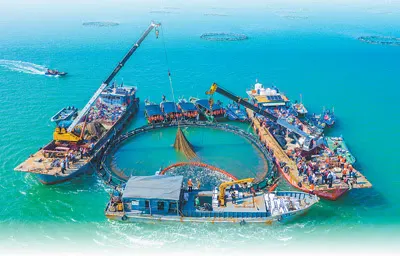Zhanjiang city in south China’s Guangdong Province has vigorously developed the marine fishery sector in recent years, cultivating a modern industrial chain of marine breeding.
With a sea area of 20,500 square kilometers, Zhanjiang boasts natural advantages in turning its vast sea waters into a “blue granary.” Shrimp fingerlings bred in Zhanjiang have been sold around the country, helping people boost incomes through the development of aquaculture.
One mariculture base under a national-level key project in the city is home to over 100 ponds for white-leg shrimp fingerlings. The breeding of shrimp fingerlings requires strict lighting, water temperature and feed conditions, said Hu Yicheng, a technician at the breeding center of the base, adding that the slightest mistake can lead to an entire pond of shrimp fingerlings failing.
Developing deep-sea and far-sea aquaculture faces many challenges, as China’s high-quality shrimp fingerling resources are scarce, said Mo Juejun, vice president in charge of the fingerling business at Guangdong Evergreen Conglomerate Co. Ltd. (Evergreen).
“To break through the development bottleneck of white-leg shrimp aquaculture, we must improve or independently develop new varieties and master technologies,” Mo added.
In 2002, Evergreen began constructing the mariculture base and started the breeding research and development of aquatic livestock such as white-leg shrimp, cobia, and grouper. Subsequently, the mariculture base has collaborated with Sun Yat-sen University to carry out research. After nearly 10 years of efforts, a new white-leg shrimp variety was developed. “This was the first disease-resistant white-leg shrimp variety certified in China,” said He Jianguo, a professor of the School of Life Sciences at Sun Yat-sen University.
“It fills the gap in the independent breeding of high-quality white-leg shrimp varieties in China. Its disease resistance index is 47.22 percent higher and its survival rate is about 20 percent higher than imported white-leg shrimp,” He added.
Today, the mariculture base covering an area of 300 mu (20 hectares) has become a comprehensive research and development platform integrating the production of fingerlings, aquaculture feed, farming, and animal protection. With an annual breeding capacity of 100,000 pairs of parent shrimps and 8 billion shrimp fingerlings, it has become China’s largest breeding base of parent white-leg shrimp.
Today, driven by the white-leg shrimp industry, Zhanjiang is gradually becoming a national breeding base for aquatic fingerlings. In 2023, Zhanjiang produced over 160 billion white-leg shrimp fingerlings, with three out of every five white-leg shrimp in China coming from the city. Last year, Zhanjiang’s total output of aquatic products reached 1.29 million tonnes, with a total output value of nearly 30 billion yuan (about $4.17 billion).
Currently, over 16,000 farming households in Zhanjiang have started farming white-leg shrimp for their short growth cycle. Currently, thanks to technological advances, north China’s Inner Mongolia Autonomous Region and northwest China’s Gansu Province and Ningxia Hui Autonomous Region have developed large-scale white-leg shrimp farming, realizing a win-win scenario for the economy and ecology.
“Our team has continuously selected parent white-leg shrimp suitable for farming in different regions,” Hu said.
The mariculture base has also succeeded in developing techniques for breeding fingerlings of 10 specialty fish species.
Zhanjiang is also dedicated to cultivating a complete industrial chain of modern marine ranching, which is inseparable from the iterative upgrading of technologies and equipment.
On June 20, 2023, Havwii 2, the largest intelligent marine aquaculture platform in Guangdong, was put into operation, joining Havwii 1, a truss fishery platform launched earlier.
Built with a total investment of 30 million yuan, Havwii 2, also a green platform, can resist strong wind and waves and requires a crew of just three or four operators, explained Liu Ding, chairman of Guangdong Havwii Agriculture Co., Ltd.
The platform adopts an intelligent management system and boasts smart equipment, cutting labor costs by up to 60 percent. It can raise 500,000 to 750,000 kilograms of medium- and high-end marine fish such as brown croaker, cobia, and giant grouper within one cycle, with an estimated annual output value of 70 million yuan, added Liu, who is highly confident in the prospects brought by the upgrade of marine aquaculture equipment.
“The intelligent aquaculture platform ensures safer and more stable deep-sea farming and plays a great role in fishery breeding,” Liu said.
Last June, Longwang Bay park in the Zhanjiang Bay Laboratory was completed and the lab’s big data center for fishery opened, helping realize the unified management of deep-sea and far-sea aquaculture systems and accelerate the collection, storage and integration of fishing data. The lab also develops systems to provide intelligent aquaculture decision support involving operation, control and early warning programs.
“We need to build a big data center of marine ranches to harness the power of big data and promote integration and transformation,” said An Ran, a researcher at the China Development Institute in Shenzhen.
Zhanjiang will accelerate the construction of a system of improved varieties of aquatic products integrating breeding, farming and promotion, promote the transformation and upgrading of fishery equipment and the development of smart fishery, and expedite the construction of modern marine ranches, said Sun Chengzhi, head of the aquaculture department of the bureau of agriculture and rural affairs of Zhanjiang.
Focusing on aspects including fingerlings, farming, processing, and circulation in the fishery industry, Zhanjiang has currently formed a complete industrial chain and supply chain covering multiple sectors such as feed production, biological pharmaceuticals, equipment manufacturing, packaging and transportation, professional services, and recreational fishery, providing strong support for the high-quality development of the city’s marine economy.
“The development of Zhanjiang’s marine ranches has also driven the improvement of industries such as cold storage, net cage manufacturing, and compound feed. The city’s sales network for aquatic products extends to more than 40 countries and regions,” Sun added.










